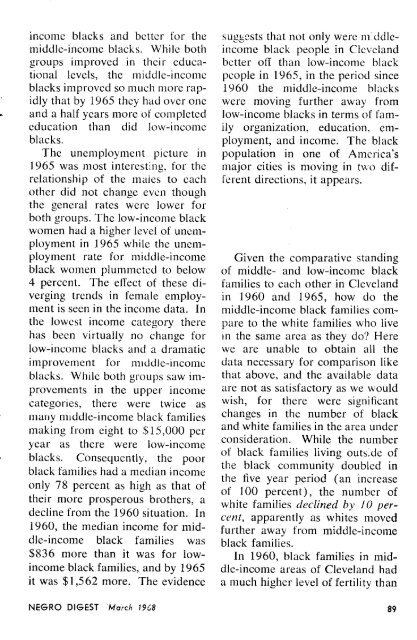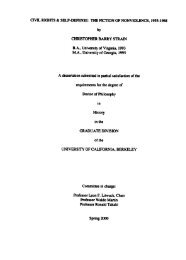Negro Digest - Freedom Archives
Negro Digest - Freedom Archives
Negro Digest - Freedom Archives
Create successful ePaper yourself
Turn your PDF publications into a flip-book with our unique Google optimized e-Paper software.
income blacks and better for the<br />
middle-income blacks . While both<br />
groups improved in their educational<br />
levels, the middle-income<br />
blacks improved so much more rapidly<br />
that by 1965 they had over one<br />
and a half years more 'of compl-eted<br />
education than did low-income<br />
blacks .<br />
The unemployment picture in<br />
1965 was most interesting, for the<br />
relationship of the males to each<br />
other did not change even though<br />
the general rates were lower for<br />
both groups . The low-income black<br />
women had a higher level of unemployment<br />
in 1965 while the unemployment<br />
rate for middle-income<br />
black women plummeted to below<br />
4 percent . The effect of these diverging<br />
trends in female employrnent<br />
is seen in the income data . In<br />
the lowest income category there<br />
has been virtually no change for<br />
low-income blacks and a dramatic<br />
improvement for middle-income<br />
blacks . While both groups saw improvements<br />
in the upper income<br />
categories, there were twice as<br />
many middle-income black families<br />
making from eight to $15,000 per<br />
year as there were low-income<br />
blacks . Consequently, the poor<br />
black families had a median income<br />
only 78 percent as high as that of<br />
their more prosperous brothers, a<br />
decline from the 1960-situation . In<br />
1960, the median income for middle-income<br />
black families was<br />
$836 more than it was for lowincome<br />
black families, and by 1965<br />
it was $1,562 more. The evidence<br />
NEGRO DIGEST 'Mach Y9L8<br />
sugg.^sts that not only were m :ddleincome<br />
black people in Cleveland<br />
better off than low-income black<br />
people in 1965, in the period since<br />
1960 the middle-income blacks<br />
were moving further away from<br />
low-income blacks in terms of family<br />
organization, education, employment,<br />
and income . The black<br />
population in one of America's<br />
major cities is moving in two different<br />
directions, it appears .<br />
Given the comparative standing<br />
of middle- and low-income black<br />
families to each other in Cleveland<br />
in 1960 and 1965, how do the<br />
middle-income black families compare<br />
to the white families who live<br />
in the same area as they do? Here<br />
we are unable to obtain all the<br />
data necessary for comparison like<br />
that above, and the available data<br />
are not as satisfactory as we would<br />
wish, for there were significant<br />
changes in the number of black<br />
and white families in the area under<br />
consideration . While the number<br />
of black families living outside of<br />
the black community doubled in<br />
the five year period (an increase<br />
of 100 percent), the number of<br />
white families declined by 10 percent,<br />
apparently as whites moved<br />
further away from middle-income<br />
black families.<br />
In 1960, black families in middle-income<br />
areas of Cleveland had<br />
a much higher level of fertility than<br />
8 9
















